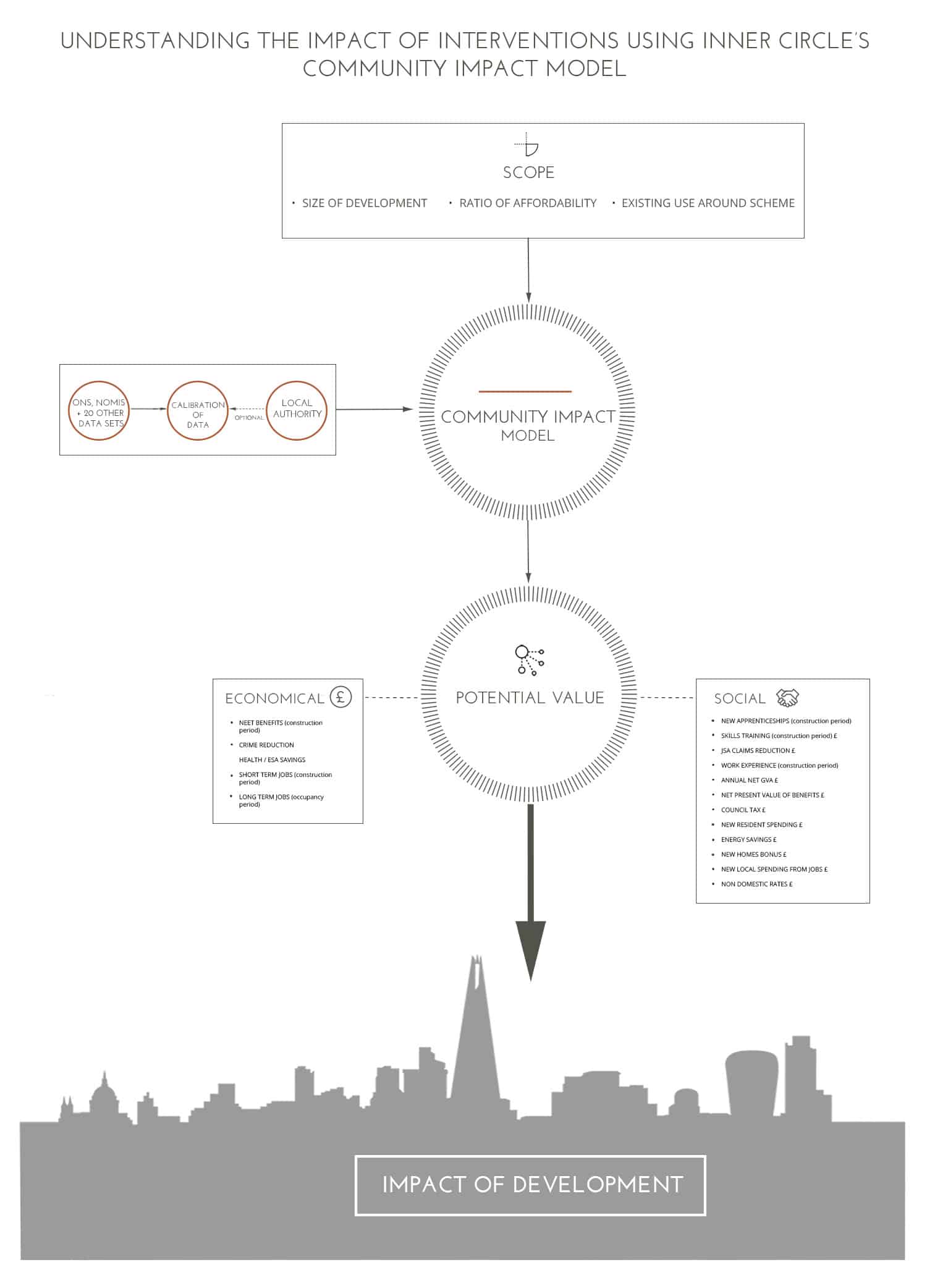Helping city leaders model the social impact of their investments
HELPING CITY LEADERS MODEL THE SOCIAL IMPACT OF THEIR INVESTMENTS

We believe that the best solutions are yet to be discovered and the best outcomes yet to be delivered. That is why we prepare organisations for change and help them implement it. We do this through an intimate understanding of their business, a relentless focus on delivery, the use of techniques that challenge the status quo and bridge traditional disciplines. We provide a range of services to public and private organisations including project and programme management, property consultancy, change management and strategy development and strategic advice. Contact us to discuss a project.
The case for meaningful ICC community impact modelling in public sector regeneration investment
The intelligent use of data and advanced analytics has only begun to penetrate the regeneration industry. As data on community impact continues to advance, the implications for public sector decision-making the redirection of resource and investments will be dramatic.
We believe that having the right data and the right approach to utilising that information is the key to making progress and achieving the best possible results in any area of work. Well before the Social Impact Bandwagon started rolling, we invested in our data analysis capabilities to create the ICC Community Impact Model (CIM), which helps governments, programmes, and projects analyse and understand the impact of their interventions. We thought we would share some insights on the culture of decision-making and how we apply our tools to help city leaders.

Decision-Making
The psychology of decision-making tells us that ‘vividness,’ which refers to how strong something features in our minds, makes up a significant portion of how we view the world. By proxy, this seeps into our personal decision-making process and often lowers our ability to receive new input or even ignore driving factors of a situation because they are new or outside our periphery.
At work we mitigate this though divisions of labour; A planning team, a legal team, an IT team, et cetera. The idea is that skills and expertise applied to a problem give a better result, but we can often miss out on the experience and creative insights of other perspectives and create siloed work environments. This is a pronounced problem in housing. Placemaking, with all of its nuances and approaches, can often be reduced to a ‘have land will build’ mentality. The reality is obviously much more nuanced: people have lives, routines and life-styles they value, places have culture and life that is unique to that community, etc. Developing places without this awareness can lead to social disenfranchise and sub-optimal returns for your investment.
At Inner Circle Consulting, we recognise the importance of capturing the impact development has on an area to both protect its integrity while allowing for growth. That is why we have developed and continue to improve our Community Impact Model, also known as CIM. The CIM uses the latest open source data about your area of construction; from current community amenities and features, to industry outputs, demographics about the areas income mix and professional profile to create a value added picture of ‘what if’? This model goes beyond community engagement by providing local governments and development agencies a statically sound method for forecasting the long term impacts of development.
Understanding impact
From our extensive experience in working with local government, they often have questions about the impact of a development. For example:
What if a developer offers a mixed-use commercial scheme and residential scheme?
What could be the long-term social payback if we invest in this marginally viable project now?
How can we optimise the our programme to get the right balance of social benefit for residents and yet secure financial payback on our investment
What effect will our investment have on affordability now and in the future?
These are important questions that get to the heart of regeneration, local benefit, and short- and long-term impact of a development. Our work with Council’s has highlighted a need to answer these questions rationally and methodically. That’s why, in 2017, we crafted our CIM programme to help provide meaningful answers to critical questions. The outputs of our CIM model give your project an objective, evidence based decision-aid tool that integrates with your existing process and policy.
A level playing field for complex decisions
The model helps our clients go beyond arbitrary comparisons between apples (financial gain) with pears (social value) by using open source, peer reviewed data to monetise social benefits and give direct comparators that aid clear decisions.
Optimising programmes
Our approach enables regeneration programme leaders to forecast potential impact of interventions to adjust their strategy and shape their delivery programmes.
Communicating with communities
Our model enables our clients to communicate the benefit of investment with communities.
Effective commissioning
Our model helps forecast impacts and create KPIs that can be used to effectively commission investment and delivery partners, ensuring their service has the maximum benefit for your place.
We have successfully applied our model for many development programmes for local governments across the UK to help them realise the true potential of their investment. Clients tell us that having more concrete information to provide to residents, which helps build trust and communication from the outset of a project that avoids disenfranchisement. Others have told us that the CIM has been the key difference in targeting locations for development, answering the more hypothetical questions of diligent councillors.
Examples of CIM in Practice
We’ve used our CIM tool in various projects across the UK. Some of the most recent ones are:
- The EMD Cinema – Waltham Forest
- Truro – Cornwall
- St Neots – Cambridgeshire
- High Wycombe – Buckinghamshire Unitary

How we can support your understanding
Using our CIM tool and our expertise we can help your planning and decision making, whether private sector investment or complex regeneration portfolio. It can apply to UK and international developments. For example, our CIM tool is being is used to understand urban design and planning in cities across the State of Florida and south eastern US. If you would like to know more about the Inner Circle Consulting’s data-driven approach and use of our CIM tool, contact us for a discussion on how we can help you achieve your goals.


